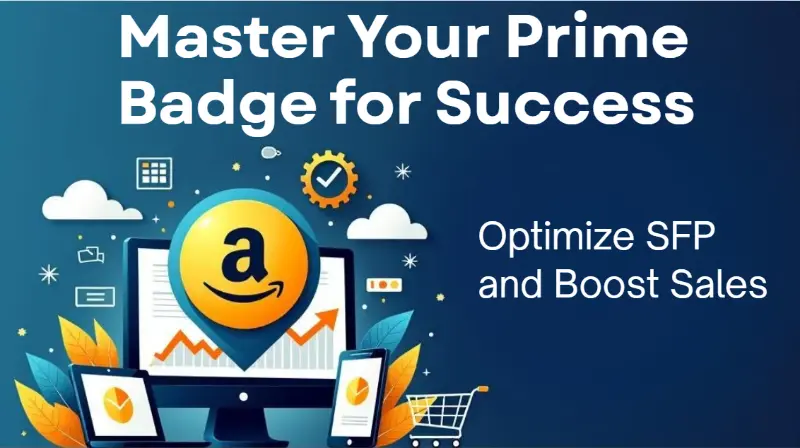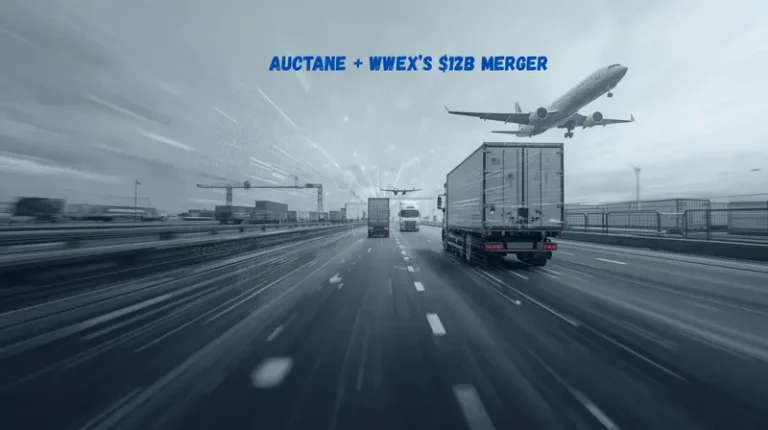Amazon Prime Badge: How Sellers Can Optimize SFP Performance in 2025

Last updated on August 26, 2025

In this article
 7 minutes
7 minutes
Seller Fulfilled Prime sounds like freedom on paper, but in reality, it’s THE toughest performance program in ecommerce. In 2025, keeping the Amazon Prime badge is a high-wire act; one late order, one canceled shipment, and the entire badge (and Buy Box visibility with it) can vanish. For Amazon sellers, the Prime badge isn’t just a logo; it’s shorthand for trust, speed, and credibility with millions of Prime customers. And Amazon enforces it with razor-sharp precision.
At Cahoot, we see every day how hard it is for sellers to balance those requirements while protecting margins. That’s why it’s worth breaking down what SFP performance really means today, the exact metrics Amazon is tracking, and how smart systems and strategies, not guesswork, are the only way to protect that coveted blue badge.
Why Seller Fulfilled Prime Badge Matters, and Why It’s Tougher in 2025
Prime customers are the holy grail: they convert higher, shop more often, and tolerate almost zero friction. Earning the Prime badge leads to higher sales due to increased visibility and trust among Prime members. Losing your Prime badge means your buy-box performance tanks, and your visibility plummets. In 2025, Amazon is watching you like a hawk: on-time delivery > 93.5%, cancel rate < 0.5%, and a lightning-fast response when a rare issue happens. Maintaining Prime eligibility and Prime status requires consistently meeting these key performance metrics to keep your products available to Prime members.
Here’s the kicker: supply chain disruptions linger, carrier delays still happen, and rate complexity trips sellers up. Amazon has seen Prime delivery complaints surge in early 2025, so they’re policing Seller Fulfilled Prime with more bots and automated reviews. To ensure customer satisfaction and provide excellent customer service, sellers must meet Prime members’ expectations for fast, reliable Prime shipping and quick issue resolution to retain the badge.
Slash Your Fulfillment Costs by Up to 30%
Cut shipping expenses by 30% and boost profit with Cahoot's AI-optimized fulfillment services and modern tech —no overheads and no humans required!
I'm Interested in Saving Time and MoneyThe Exact SFP Metrics That Make or Break You
Amazon mandates: new 2024 shipping and delivery policies
- On-Time Delivery Rate (OTD): ≥ 93.5% – Ship late, and your badge gets flagged.
- Valid Tracking Rate (VTR): ≥ 99% – missing or late tracking? End of story.
- Pre-Fulfillment Cancel Rate: ≤ 0.5% – every cancel hurts.
- Strict one- and two-day delivery promises across 48 states
- Minimum Product Detail Page Views by product size tier
- 100 minimum shipments per month to even qualify
To qualify for SFP, sellers must have a professional selling account and successfully complete the official trial period, meeting all required metrics.
Note: all across 30-day rolling windows. One bad quarter, and you’re up for manual review, or worse, auto-suspension. Managing shipping costs is also crucial for maintaining compliance with SFP requirements.
How to Nail SFP Performance (Even With Small Team or Lean Ops)
1) Build Speed into Ops, Not Hype
- Batch-pick orders early. Always aim to pack and hand off by midday, not the end of the day, to meet Prime’s fast standards for speedy delivery and fast and reliable shipping.
- Use shipping APIs that auto-prioritize Prime lanes without manual toggles to help ensure reliable shipping practices.
- Monitor ETA cutoffs for your regular carriers and test express backups, as reliable shipping is critical for meeting Amazon’s expectations.
2) Over-Deliver on Tracking
- Auto-push tracking as soon as the label prints.
- Validate tracking format before upload; Amazon bots punish malformed data.
- If your carrier is flaky, add a second provider or backup (especially for rural destinations).
- Implement real-time inventory tracking to ensure accurate order fulfillment and prevent stockouts.
- Monitor customer feedback related to shipping and tracking to quickly identify and resolve any issues.
3) Prevent Cancels like a CEO
- Never “hope it lands.” Hope is not a strategy. Use buffer stock, or auto-route to FBA if you’re under threat.
- Effective inventory management is crucial; monitor your storage space closely to ensure you have enough stock on hand and avoid last-minute cancellations.
- Understanding product category-specific risks can help you anticipate demand fluctuations and prevent stockouts that lead to cancellations.
- If a stock issue comes up, cancel proactively before the SFP badge gets flagged, and contact buyers where possible.
- Watch the “future release risk”; don’t oversell what isn’t in your warehouse yet.
4) Fix Defects Fast
- Set alerts for negative feedback or A-to-Z claims. Address and refund within 24 hours.
- Promptly address customer service inquiries to ensure customer satisfaction and resolve issues before they escalate.
- Monitor customer messages daily and respond within minutes.
- Providing excellent customer service is key to resolving defects and maintaining Prime eligibility.
- If a product causes repeated issues, pause SFP listings on it until the root cause is solved.
5) Use Tools That Ready Your Stack
- Dashboards like Cahoot’s surface SFP metrics in real time, flag at-risk orders, and suggest next actions. Leveraging real-time inventory tracking tools within your fulfillment process helps monitor stock levels, avoid stockouts, and ensure efficient order fulfillment.
- Automate reporting: have OTD, VTR, and cancel funnel dashboards you can glance at before Amazon does. Staying ahead in the competitive landscape requires continuous monitoring and adjustment of your SFP strategies to respond to changes and maintain high performance.
Stretch Goals That Keep You Ahead of the Curve
- Test local courier options in high-risk ZIP codes for same-day assurance.
- Stagger dispatch so that slow zones don’t pile up late-hand opening issues.
- Return workflows: quick pickups with prepaid labels reduce returns drag on ODR.
- Seasonal boosts: plan staff and carrier guarantees for Prime Day and holiday surges.
- Leverage exclusive deals and prime offers during events like Prime Day to boost sales and attract Prime members with special discounts and fast shipping.
- Integrate other sales channels, such as your own website or external marketplaces, to expand reach and maximize SFP performance.
Looking for a New 3PL? Start with this Free RFP Template
Cut weeks off your selection process. Avoid pitfalls. Get the only 3PL RFP checklist built for ecommerce brands, absolutely free.
Get My Free 3PL RFPWhat To Do Monday Morning
- Pull your last 30 days of SFP performance. If any metric is close to thresholds, act immediately.
- Review real-time inventory tracking data to quickly identify potential stockouts or overstock issues.
- Evaluate your fulfillment process for efficiency, ensuring all steps from packing to shipping meet Amazon’s requirements.
- Monitor shipping fees closely to maintain profitability and consider strategies to reduce costs or offer free delivery where possible.
- Confirm courier ETA averages vs. Amazon cutoff times. Adjust the clock.
- Embrace the tool that automates tracking validation and alerts.
- Run test orders to rural areas to audit actual delivery performance.
The Bottom Line
Maintaining the Prime badge via SFP is no mystery, it’s detail and discipline wrapped in speed. The brands that nail it aren’t the fastest; they’re the most consistent. They protect margins because they built structural resilience, not wishful workflows. Be precise, proactive, and responsive, and your Prime badge remains your best badge.
Frequently Asked Questions
How fast must I ship to keep the Prime badge?
Ideally, same-or-next-day pickup with your carrier, aiming for delivery well before the customer sees a “slower shipping” estimate. Late shipments still count, regardless of holidays or weather. Buffer, even one-hour picks help.
What’s the easiest way to avoid tracking-related issues?
Use shipping tools that auto-validate tracking numbers, ensure they follow Amazon’s format, and auto-upload to Seller Central through API. Manual uploads always risk errors or mismatches.
My Amazon cancellation rate is high. How do I fix it?
Inventory buffer. Auto-route to FBA when stock dips. Or proactively cancel orders before they ship and offer a solution. One preventative cancel is better than badge loss.
What should I prioritize for SFP if I’m juggling orders and compliance?
OTD and Page Views. Those two metrics matter more than any other. If both are healthy, minor tracking glitches are usually forgiving.
Can I use multiple carriers for SFP?
Yes, and you probably should. Multi-carrier strategy protects against one carrier’s delays, system outages, or regional slowdowns. Just monitor all carrier performances vigorously.

Turn Returns Into New Revenue





